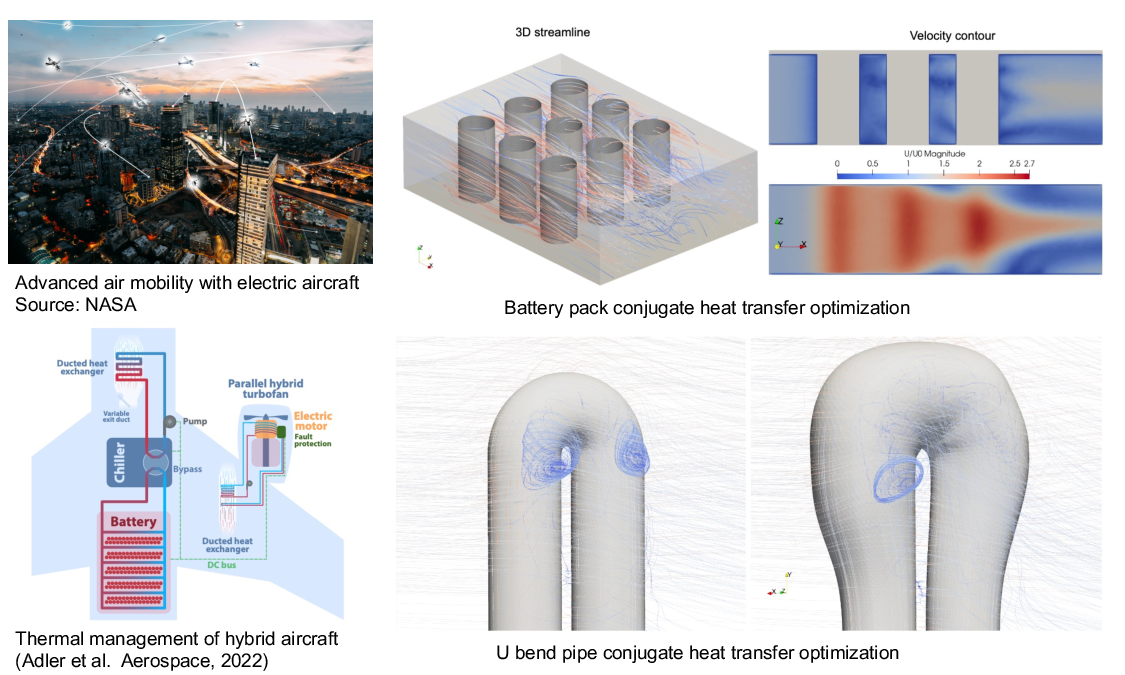High-fidelity Multidisciplinary Design Optimization of Heat Exchangers for eVTOL Aircraft Thermal Management. National Aeronautics and Space Administration (NASA-EPSCoR-R3. 8/2023 to 8/2025)
The objective of this project is to develop the capability to rapidly design high-performance heat exchangers for electric vertical take-off and landing (eVTOL) aircraft thermal management, under NASA’s OpenMDAO/MPhys framework. eVTOL aircraft is the next-generation aviation concept in NASA’s Advanced Air Mobility Mission as it enables zero-emission, on-demand air taxis and is poised to transform how people live and connect. However, eVTOL aircraft do not have a natural way to dissipate the heat accumulated in their electric motors, which may cause the failure of other components, such as the battery. An urgent need is to design efficient heat exchangers to dissipate the heat with a minimal penalty to the aircraft’s overall performance, i.e., minimal pumping power and weight.
In this project, we will extend the OpenMDAO/MPhys framework’s capability for conjugate heat transfer optimization of various heat exchanger configurations. OpenMDAO is an open-source multidisciplinary design optimization (MDO) framework developed at NASA, with MPhys being one of its derivatives for high-fidelity optimization, e.g., computational fluid dynamics (CFD). MPhys currently has an aerothermal interface that can conduct conjugate heat transfer for simple geometries. However, it faces a main technical challenge when extending for complex geometries, such as ducted heat exchangers. This project will break this limit by creating a new MPhys aerothermal interface that can handle various complex geometries and working conditions. To pursue the above objective, we will conduct three research tasks. (1) Develop the aerothermal data transfer functions to extract heat flux and temperature at the conjugate heat transfer boundary through DAFoam (a high-fidelity multiphysics solver being actively developed by the science investigator at Iowa State University). (2) Create a new MPhys aerothermal interface to use DAFoam for conjugate heat transfer optimization. (3) Conduct CFD-based conjugate heat transfer optimizations for a plate-fin heat exchanger. The objective is to minimize the pumping power and weight of the heat exchanger while dissipating a prescribed heat flux (constraint). We will perform multi-objective and multipoint optimizations to balance the performance between pumping power and weight at different heat flux (motor power) levels. The new MPhys aerothermal interface can also be used for optimizing other heat exchanger configurations using high-fidelity CFD.

Publications:
-
P. He, C. Psenica, L. Fang, M. Leader. Aerothermal Shape Optimization of Actively-Cooled Battery Packs Using Conjugate Heat Transfer. AIAA SciTech Forum, 2025.
-
C. Psenica, L. Fang, S. Zoppelt, P. He. Conjugate Heat Transfer Shape Optimization of a U-bend Pipe With a Discrete Adjoint Method. AIAA SciTech Forum, 2025.